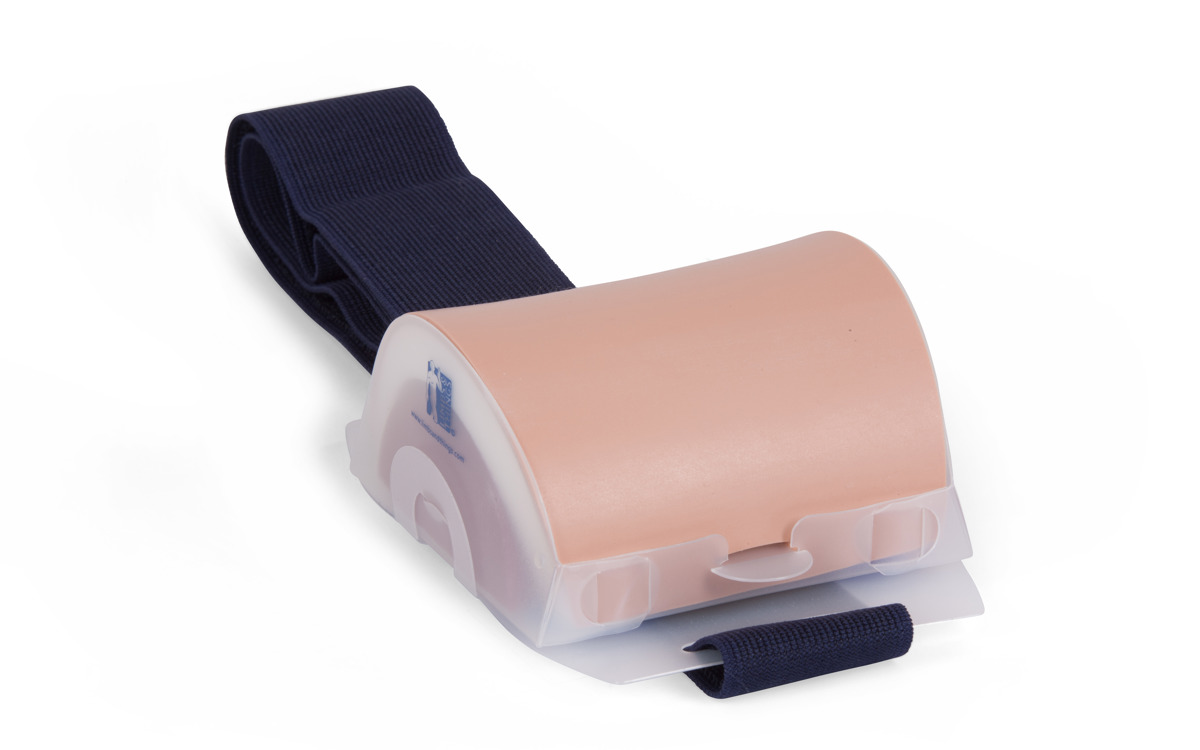



Limbs & Things’ Injection Trainer is the ideal simulation trainer to facilitate the practice and administration of intradermal, subcutaneous, and intramuscular tissue injection techniques.
The trainer features realistic and easily identifiable tissue layers that represent the epidermis, dermis, adipose, and muscle. The receptive anatomical layers make this an ideal tool for teaching correct needle positioning to beginners and more clinically experienced individuals.
Included with the trainer is a removable epidermis that enables intradermal injections to be performed. The injectant is filled between the epidermis and soft tissue skin pad and can be identified as successful when a bleb occurs.
Limbs & Things’ Injection Trainer is the ideal simulation trainer to facilitate the practice and administration of intradermal, subcutaneous, and intramuscular tissue injection techniques.
The trainer features realistic and easily identifiable tissue layers that represent the epidermis, dermis, adipose, and muscle. The receptive anatomical layers make this an ideal tool for teaching correct needle positioning to beginners and more clinically experienced individuals.
Included with the trainer is a removable epidermis that enables intradermal injections to be performed. The injectant is filled between the epidermis and soft tissue skin pad and can be identified as successful when a bleb occurs.
The epidermis is easily removable for cleaning. This Injection Trainer comes with two epidermises to maximize the number of injections performed before needing a replacement, making it a cost-effective trainer.
The fluid-absorbent Skin Pad allows learners to experience repeatable and realistic subcutaneous and intramuscular injections.
The trainer is lightweight, portable, and comes with a strap-on base plate to be attached to an arm or thigh of a simulated patient. This allows for scenario-based training to help teach professional-to-patient communication. Alternatively, injection procedures can be performed on tabletop.
Overview
• Epidermis layer peels back to quickly release subcuticular liquid
• Multiple tissue layers – epidermis, dermis, adipose tissue, and muscle
• Can be used in scenario-based or tabletop training
• Durable material for repeated injections
Realism
• Tissues are soft and to the touch
• Accurate representation of epidermis, dermis, subcutaneous adipose, and muscle layers which facilitate true to life needle resistance
• Realistic elasticity of skin
Versatility
• Adjustable strap for hybrid simulation
• Durable replaceable epidermis
• Re-usable foam block and pad to absorb liquid from injection
Cleaning
• Can be cleaned by wiping with soap and water
Safety
• This product is latex free
• When practicing injection, only use water
• Ensure the product is completely dried after use and stored in its box between sessions
• Recommended: allow up to 48 hours before using the trainer for the product to reach room temperature. Very low temperatures can make the material brittle and inflexible
Anatomy
• Trainer represents a common injection site on a patient
• Epidermis, dermis, adipose (fat) and muscle
Skills Gained
Skills gained:
- Subcutaneous injection
- Intradermal and intramuscular injection
- Management of tissue
- Professional-to-patient communication
References
AAMC (2008) - Recommendations for Preclerkship Clinical Skills Education for Undergraduate Medical Education p.29 Appendix 7: Clinical Procedures. Correctly perform subcutaneous and intramuscular injection • Maintains aseptic technique, the proper angle and depth of needle insertion. Performs the process of injection, and proper disposal of the needle
Health Workforce Australia, Medical Graduate Competency Framework Stage 2 Final Report, 2012 Procedure: Subcutaneous injections, intramuscular injections - Performed in the clinical environment under structures supervision
CPMEC Australian Curriculum Framework for Junior Doctors version 3.1, 2012, p.31 ...provide safe treatment to patients through competently performing certain procedures... Injection of local anaesthetic to skin Subcutaneous injection Intramuscular injection Administration of IV medications, injections and fluids
Practical Skills and Procedures, General Medical Council, April 2019, p.6 Prescribing 17. Prepare and administer injectable (intramuscular, subcutaneous,intravenous) drugs... and prefilled syringes
NMC Future nurse: Standards of proficiency for registered nurses, 17 May 2018, p.37 11.7 administer injections using intramuscular, subcutaneous,intradermal and intravenous routes and manage injection equipment
NHS National Practitioner Program: Matrix Specification for the Physician Associate (2016). p.127: Core Procedural Skills: Injection- IM Injection –SC (Insulin, LMW Heparin)
GMC Outcomes for provisionally registered doctors with a licence to practise (The Trainee Doctor), 2015 p. 8: Core clinical and procedural skills ...: Injection of local anaesthetic to skin, Injection – subcutaneous (eg insulin or LMW heparin), Injection – intramuscular
College of Paramendics, Paramedic Curriculum Guidance (3rd Edition Revised 2015) C 1.7.3 Apply collaborative pain assessment and management.
How do you replace the Epidermis on the soft skin injection simulator?
The epidermis can be easily removed, and a replacement can be transferred onto the injection simulator using our Epidermis Wallet included with the kit. For full details on the process, you can view our user guide
Do you offer replacement parts for the Limbs & Things Injection Trainer?
Yes, we offer a bundle that includes a Skin Pad and Muscle block for the Injection Trainer which can be easily and quickly replaced.
How thick is the epidermis layer of the Injection Trainer?
The epidermis layer comes with a standard thickness between 0.5 – 0.8mm which is representative of the average thickness of common injection sites seen on the human body.








